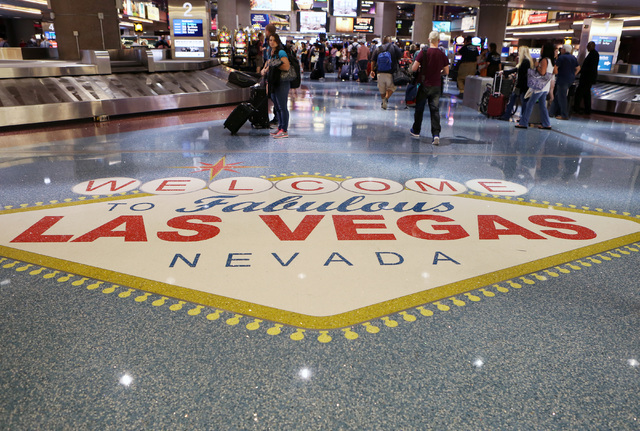Red tape, regulatory issues and more seen hampering Chinese visitation

SQUAW VALLEY, Calif. — An estimated 3.5 million Chinese tourists are wanting to travel to the United States next year but may never get here because of regulatory issues, government red tape and airlines and airports that aren’t ready for them.
The rush of international visitors is occurring at a time when the aviation industry is in the midst of massive change, Mike Boyd, president and CEO of Evergreen, Colorado-based Boyd Group International, said Monday.
About 300 people are attending Boyd’s 21st annual International Aviation Forecast Summit at the Resort at Squaw Valley, home of the 1960 Winter Olympics.
Industry leaders are projecting that 20 million Chinese visitors will travel to the U.S. over the next 10 years with hundreds of thousands of them considering Las Vegas as a destination — not just because of its reputation as an entertainment, retail and gaming hub, but because it’s centrally located among several national parks and touches the western cowboy culture that fascinates Chinese visitors.
Las Vegas is expected to capitalize on new nonstop flights between Beijing and McCarran International Airport beginning in December on Hainan Airlines, China’s fourth-largest commercial air carrier.
In his forecast on Chinese travel, Boyd said he expects Las Vegas to see the sixth highest number of Chinese arrivals among U.S. cities.
Las Vegas should anticipate 88,684 arrivals by the end of the year. With Hainan’s presence, that amount is expected to jump to 173,821 in 2018, 293,758 by 2020 and 1.1 million by 2025.
Only Los Angeles, San Francisco, New York, Washington, D.C. and Boston would have more Chinese visitors than Las Vegas. The rest of the top 10 includes Orlando, Fla., Denver, Chicago and Honolulu, according to the forecast.
Chinese travelers are desirable guests because they spend more freely than their domestic contemporaries and dollar amounts are projected to increase.
Chinese travelers spent an average of $2,594 per trip in 2008. By 2011, that expanded to $6,096, and last year it reached $13,490, thanks to greater extravagance and longer trips.
But Boyd warned that the pent-up demand to visit the U.S. could be hampered by America being ill-prepared to host those arrivals.
“Our gateways (airports where most inbound travel occurs) are shameful,” Boyd said. “Virtually every U.S. gateway is unfriendly and unprepared for foreign visitors.”
The problem is that there is little signage directing Chinese visitors through the airport and virtually nothing once they leave it. Boyd said informational programs and assistance are not in place in airports across the country. He said McCarran officials are working toward making the airport more China-ready.
There are other issues that could slow the tide of Chinese arrivals.
Currently, there is a limited number of nonstop flights between China and the United States because the two governments have not negotiated an open-skies agreement. Under an existing bilateral agreement between China and the U.S., Chinese air carriers are limited to 180 flights a week from what are categorized as Zone 1 cities — Beijing, Shanghai and Guangzhou.
There are no limits on flights to and from other Chinese cities, but there is greater risk to the airlines for making such flights profitable.
Zhihang Chi, vice president and general manager of Air China in North America, told seminar attendees that the number of flights by Chinese carriers between China and the U.S. has hit capacity and there probably won’t be any movement toward changing that until after the November election.
“Nothing is going to happen until the election cycle is over and we find out what the philosophy is going to be,” Zhi said. “We can’t open up Denver. We can’t open up Phoenix.”
The cap on flights also doesn’t bode well for increases to Las Vegas, either by Hainan or another carrier. Zhi said it isn’t likely another carrier would be allowed to fly between Beijing and Las Vegas, and that the only other scenario would be for a carrier to fly Shanghai or Guangzhou to and from McCarran.
“We’ll be missing tremendous economic impact across the United States,” added Boyd, who said it’s strictly a political issue. “We’re not taking advantage because of this nonsense.”
The potential expansion of the Chinese market is playing out at a time when the aviation industry is undergoing change.
Aircraft manufacturers are adjusting to market changes and are building larger, faster and more efficient planes. One of the effects of stepped-up security efforts at airports is a decline in short-hop markets.
But airlines are also able to fly farther thanks to efficiencies developed by Boeing with its 787 Dreamliner aircraft and Airbus Industries with its Airbus A350 jets.
Extended-range flights and more comfortable rides with products like lie-flat beds is changing where airlines can fly without stopping.
There’s even a manufacturer that plans to unveil a new supersonic aircraft and have it flying commercially by 2020.
Ultralow-fare carriers like Las Vegas-based Allegiant Air, Frontier Airlines and Spirit Airlines are altering demand patterns.
Now that fuel costs have stabilized, airlines are gearing to take advantage with new strategies. Airlines are now looking at how to maximize profits with $40-a-barrel oil prices instead of levels around $100 a few years ago.
“It’s a new reality,” Boyd said. “There are no trend lines in aviation. It’s breakthroughs that drive the future.”
Contact Richard N. Velotta at rvelotta@reviewjournal.com or 702-477-3893. Follow @RickVelotta on Twitter.












